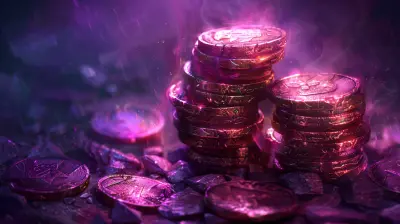The Role of Virtual Currency in Modern Gaming
25 July 2025
If you've spent any time gaming lately, you've probably noticed something that’s become as ubiquitous as loading screens: virtual currency. Whether you're buying skins in Fortnite, unlocking new card packs in Hearthstone, or grinding for those elusive gold coins in World of Warcraft, virtual currency has become the backbone of modern gaming. But what exactly is it, how did we get here, and why has it become so central to the gaming experience? Let’s dive in and unravel this fascinating (and sometimes frustrating) aspect of the gaming world.
What Is Virtual Currency in Gaming?
Let’s not overcomplicate things. Virtual currency is the in-game money you use to buy stuff—whether it’s a new weapon, character, costume, or even an experience boost. Unlike real-world cash, virtual currency exists solely within the game’s ecosystem. It's like Monopoly money, but way more addictive and valuable (at least to gamers).Virtual currency usually comes in two flavors: earned and bought. Earned currencies require you to play the game, complete tasks, or participate in events to accumulate it. Bought currencies, on the other hand, are obtained through microtransactions using real-world money. Yep, game developers found a way to make you pay for imaginary coins—genius, right?
Why Has Virtual Currency Become So Popular?
Now, here’s the million-dollar question (or maybe the 1,000 V-Buck question?): Why is everyone so obsessed with virtual currency? To answer that, we need to look at a few key factors.1. Revenue Generation for Developers
Let’s be honest—game development isn't cheap. Studios invest millions into creating immersive worlds, compelling stories, and top-notch graphics. So, how do they recoup their costs, especially when many games are now free-to-play? Ding, ding, ding—virtual currency!Microtransactions powered by virtual currency have become a cash cow for developers. Instead of selling games outright for $60, they can offer them for free and make money piecemeal as players buy virtual currency over time. Think about it: Would you rather milk one cow once or keep milking it every day? Exactly.
2. Player Engagement
Virtual currency is like that carrot dangled in front of a horse. It keeps players invested in the game by offering rewards that feel just within reach. By gamifying purchases—like offering daily login bonuses or discounts for limited-time items—developers create a loop of engagement. You log in, you buy, you play, and then you log in again the next day to do it all over.3. Customization and Personalization
We all want to stand out, right? In gaming, virtual currency unlocks a world of personalization. Whether it’s equipping your avatar with a golden helmet or decking out your car with neon underglow, virtual currency gives players the freedom to express themselves. And let’s face it—there’s just something satisfying about rolling into a battlefield dressed like a badass ninja or a banana (thanks, Fortnite).
The Evolution of Virtual Currency in Gaming
Virtual currency hasn’t always been the juggernaut it is today. It’s come a long way from the early days of gaming. Let’s take a quick look at how it evolved.1. The Early Days: Coins and Points
In the '80s and '90s, virtual currency was simple. Games like Super Mario Bros. and Pac-Man used coins and points as a way to track progress or earn extra lives. Nobody paid real money for these, and they were entirely earned through gameplay.2. The Rise of MMOs
Enter the late '90s and early 2000s, where Massively Multiplayer Online (MMO) games like EverQuest and World of Warcraft introduced in-game economies. Players could grind for gold to buy items or trade with others. This is where things started to shift—players began to assign real-world value to virtual goods.3. The Era of Microtransactions
By the mid-2000s, the gaming industry saw the rise of microtransactions. Games like MapleStory and FarmVille popularized the idea of buying small, incremental content using virtual currency. And once smartphones became gaming devices? Forget about it. Mobile games like Candy Crush and Clash of Clans absolutely dominated with microtransaction models.4. Today: Virtual Currency Everywhere
Fast forward to today, and virtual currency is everywhere. Almost every genre, from first-person shooters to sports simulators, incorporates it. Whether it's Robux in Roblox or FIFA Points in FIFA, virtual currencies have become an integral part of how games are designed and monetized.
The Pros and Cons of Virtual Currency
Virtual currency isn’t all sunshine and rainbows. Sure, it can enhance the gaming experience, but it also brings its fair share of challenges. Let’s break it down.Pros
- Enhanced Gameplay: Virtual currency allows players to unlock cool items, new characters, and exclusive content, often making the game more exciting and fresh.- Accessibility: Free-to-play games with virtual currency lower the barrier to entry, allowing more people to enjoy the game without an upfront cost.
- Revenue for Developers: It funds continuous updates, expansions, and servers, ensuring the longevity of the game.
Cons
- Pay-to-Win Dynamics: Some games lean heavily on paid virtual currency, creating an uneven playing field where players with deeper wallets dominate.- Addictive Spending: Let’s not sugarcoat it—virtual currency can be a slippery slope. It’s easy to lose track of how much real money you’re spending when $1 translates to 100 gems.
- Gambling Concerns: Loot boxes and randomized rewards purchased with virtual currency have been criticized for resembling gambling mechanics, sparking debates among lawmakers and consumer groups.
The Psychological Hook of Virtual Currency
Why do we feel so compelled to buy virtual currency? The answer lies in psychology. Game developers are masters at leveraging human behavior to encourage spending. Let’s look at some tricks they use:1. The FOMO Effect
Ever been hit with a limited-time offer that you "just can’t miss"? That’s fear of missing out (FOMO) in action. Games often use timers or exclusive items to create a sense of urgency, pushing you to spend your hard-earned cash on virtual currency ASAP.2. The Sunk Cost Fallacy
If you’ve already spent hours (or dollars) grinding or investing in a game, you’re more likely to keep spending. It’s hard to walk away when you’ve already sunk so much into it.3. The Satisfaction of Instant Gratification
Buying virtual currency for an immediate reward or power-up feels good. Developers capitalize on this by making purchases as seamless as possible—just a couple of clicks, and you’re leveling up.The Future of Virtual Currency in Gaming
So, what’s next for virtual currency? While it’s hard to predict the future, a few trends are already emerging:1. Blockchain and Cryptocurrency
Games like Axie Infinity and Decentraland are introducing blockchain-based currencies that can be traded outside the game. This could blur the lines between virtual and real-world economies even further.2. Subscription Models
Some games might shift away from microtransactions and instead offer monthly subscriptions that include bundles of virtual currency. Imagine Netflix, but for your game spending.3. Regulation
With growing concerns over gambling mechanics and addiction, governments might impose stricter regulations on how virtual currencies are implemented and marketed.Final Thoughts
Love it or hate it, virtual currency is here to stay. It’s transformed gaming into an experience that’s not just about playing but also about personalization, community, and, yes, spending. While it has its downsides, when done right, virtual currency can enhance the gaming experience in ways we never thought possible—like equipping a banana suit in a battle royale. Who wouldn’t want that?At the end of the day, it’s all about balance. Virtual currency should add to the fun, not take away from it. So, the next time you buy that shiny new skin or those extra lives, just remember: Virtual currency might be fake, but the fun it brings is very real.
all images in this post were generated using AI tools
Category:
In Game PurchasesAuthor:

Lana Johnson
Discussion
rate this article
1 comments
Judith Clayton
Virtual currency shapes player engagement and game economies, balancing enjoyment with the complexities of monetization strategies.
August 10, 2025 at 3:23 PM

Lana Johnson
Thank you for your insight! Indeed, virtual currency plays a pivotal role in enhancing player engagement while also navigating the intricacies of monetization in the gaming industry.


